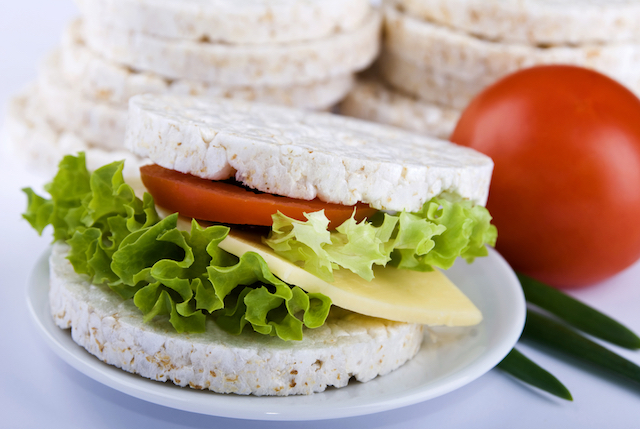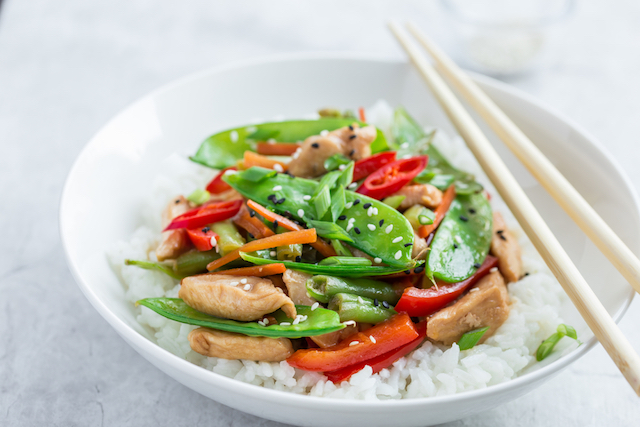- Home
- Blog
- Healthy Eating for Wellness
- Eat to beat gluten intolerance and coeliac disease (Part 2)
Eat to beat gluten intolerance and coeliac disease (Part 2)
Written by Catherine Saxelby
on Wednesday, 13 March 2019.
Tagged: gluten, gluten intolerance, gluten-free, health, healthy eating, healthy lifestyle, nutrition

Part 1 of this post dealt with which foods to avoid and gave the options for substituting other foods. Part 2 provides those with gluten intolerance or coeliac disease a meal plan to follow.
Gluten-free meal plan
Breakfast
Fresh fruit
Cornflake or puffed rice cereal or gluten free muesli (check label for malt-free) with milk or plant mylk
1-2 tablespoons rice bran/psyllium/Hi-Maize/Benefiber, if needed for fibre
Gluten-free bread, toasted, with margarine and yeast spread, peanut butter, cottage cheese, jam or marmalade
Egg, grilled tomatoes or mushrooms (optional)
Tea, coffee or milk or plant mylk such as almond mylk or soy mylk
Morning tea

Rice or corn cakes with sliced tomato and cheddar cheese OR
Fruit Rice loaf, toasted and spread with margarine
Tea, coffee, milk or plant mylk
Lunch
Stir-fried chicken or pork and vegetables
Steamed rice or rice noodles
Tub of fruit salad
Mineral water, soft drink, fruit juice or milk or plant mylk drink (not malted)
Afternoon snack
Carton of fruit yoghurt (check ingredients) OR a gluten-free fruit muffin
Dinner

Meat, chicken or vegetarian bean curry
Potato, rice, quinoa or backwheat groats
Vegetables or salad with oil-vinegar dressing
Stewed apple with ice cream or custard (check ingredients)
Tea, coffee or cup of hot milk or plant mylk
Cooking hints
- Keep rice flour, arrowroot, soy flour or potato flour for thickening sauces, soups, casseroles and gravies.
- Make sauces and dressings from ingredients you are sure are free of wheat e.g. oil, vinegar, garlic, pure herbs, grated lemon rind, etc
- Invest in a bread maker and use a quality wheat-free bread mix to bake fresh bread at home.
- Substitute soy flour or rice flour or potato flour or corn flour for the wheaten flour in your favourite cake or biscuit recipes. A blend of 1/3 soy flour with 1/3 rice flour and 1/3 potato flour or corn flour is a good mix, but remember that you will need to vary the quantity of liquid needed in some recipes. Or simply use a gluten-free pre-mix.
- Add a little baby rice cereal into rice flour or maize corn flour to give a lighter texture to cakes.
- Cook Asian style dishes like stir-fries and curries, based on rice, rather than wheat. An electric rice cooker may be a worthwhile investment.
Shopping tips
- Labelling laws mean that looking for gluten-containing ingredients will not be such a chore. The presence of gluten in ANY food ingredient must be declared on the label, no matter how small the amount.
- Check labels for ingredients that could be sources of gluten such as wheatmeal, bran, semolina, cornflour, malt or starch.
- Look for terms such as: STARCH, CEREAL FILLER, CEREAL PROTEIN, VEGETABLE PROTEIN. Some gluten-free foods carry a gluten-free logo, which is an ear of wheat which a large cross over it.
- Check the ingredient list for additives like STARCH or THICKENER (additives code numbers 1400 to 1450). If they are derived from maize or potato, they will generally say so. If it doesn't tell you, assume they are made from wheat and should be avoided. Look out also for the flavour enhancers 620-625 and the enzyme or flour treatment agent 1100.
- Keep a stock of gluten-free breads, muffins and cakes in your fridge or freezer. Most will keep in the fridge if kept unopened. For longer storage (say up to 6 months), store in the freezer in their bags.
- Stock up on rice, rice noodles, buckwheat and alterative grains.
- Coeliacs can obtain food lists and recipes from the Coeliac Society in each State. Check their website for events and food lists.
The bottom line
You can get good at cooking gluten-free at home where you control the ingredients. It’s infinitely harder when eating out where you can’t be sure unless they advertise they are gluten-free. Always remember, if in doubt, leave it out!
You may also be interested in...
References / External articles
Foodwatch
The Good Stuff
The Boring Stuff
© 2025 Foodwatch Australia. All rights reserved
Website by Joomstore eCommerce





